Basic Care for Tropical Freshwater Aquariums
In the article I’m going to tell you about Basic Care for Tropical Freshwater Aquariums. Tropical freshwater aquariums are probably the most common type of fish tanks kept and they are enjoyed by numerous people from all walks of life.

Contents
Basic Equipment for the Tropical Freshwater Aquarium
Every tropical freshwater aquarium needs the following basic equipment:
- aquarium
- aquarium stand
- heater
- thermometer
- filter
- lighting
- hood
- gravel (optional)
- aquarium plants (optional)
In addition to the above equipment which is used for the fish tank itself, you’ll also need:
- siphons and buckets for doing water changes
- water monitoring tests for pH, ammonia and nitrite
- water additives designed to remove chlorine and/or chloramine
Purchasing Your Tropical Freshwater Aquarium
When purchasing the tank for your tropical freshwater aquarium,
- choose the largest size of tank you can afford. Larger bodies of water are more stable than small bodies and your fish will appreciate tank conditions which do not change rapidly.
- choose a tank that is long, wide and short as opposed to a tank which is narrow and tall. This allows for more surface area which aids in gas exchange and helps keep the tank and fish healthy.
Deciding Where to Locate Your Tropical Freshwater Aquarium
When deciding where to place your tropical freshwater aquarium,
- do not place the aquarium near a window or door. Excess light reaching the tank can cause problems with algae which can be impossible to control. Temperature fluctuations will make it difficult to control the temperature in the tank.
- make certain your floor can support the aquarium. Remember, water is heavy and an aquarium holding 50 gallons of water may approach 500 pounds of weight.
- make certain the aquarium stand is sturdy and able to support the weight of the aquarium.
Setting Up and Filling Your Tropical Freshwater Aquarium
Once your aquarium is in place, add gravel if you will be using it on the bottom of the tank. Make certain to rinse the gravel before placing it in the tank.
Place your tank decor in the tank and arrange it so that the appearance is pleasing for you.
Place a saucer in the center of the tank at the bottom and pour water directly into the saucer, allowing the water to spill over the sides of the saucer. This will help keep the gravel and tank decor in place while you are adding water.
If you will be adding live plants to the tank, fill the tank to approximately 1/4 to 1/2 full, place the plants in the gravel where you want them and continue filling the tank with water once the plants are in place. A planted aquarium can help regulate ammonia and nitrite waste products in your aquarium and improve the water quality in your tank.
Set up your filter, heater, thermometer, lighting and hood.
Your filter should contain a sponge like component to filter large debris from the water and a compartment for chemical filtration. Activated charcoal is most often used as the chemical filtrant because it adsorbs unwanted chemicals from the water. However, there are other alternatives for removing chemicals such as ammonia from the aquarium water as well.
The tropical freshwater aquarium should be kept at a temperature of 72-82 degrees (Fahrenheit).
Adding Freshwater Fish to Your Tropical Freshwater Aquarium
Allow the water in your newly set-up tank to equilibrate for at least 48-72 hours before adding any fish to the fish tank.
After the tank has been running for 48-72 hours, check to make certain all equipment is functioning properly. If so, you are now ready to add a few fish to the tank.
Start by adding only one or two very hardy fish, such as guppies. You will need to give the tank time to cycle and adjust itself to the new fish before you add any more fish.
If you add too many fish at once, you will overload the tank and cause the ammonia and nitrite levels in the aquarium to rise. These chemicals are toxic to your fish and will kill them if the levels get to high. For this reason, you will need to monitor the levels of ammonia and nitrite as well as the pH level of the tank. You can buy commercial kits to assist you with these measurements or take a sample of water to your local aquarium store where they can test it for you.
You should expect to see a spike in the ammonia level, followed by a spike in the nitrite level as the tank adjusts to the fish in it. If the levels get too high, you may need to siphon off some of the water from the tank and replace it with clean water from which you have removed any chlorine or chloramine. This is known as a “water change”.
Once the ammonia and nitrite levels are back to normal, you can add a small number of new fish to the tank and repeat the process.
Now that your tropical freshwater aquarium is set up, you will need to maintain it on a regular basis.



